Multiple Myeloma
Article Sections
Introduction
Multiple myeloma (MM) is a hematologic neoplasm of plasma cells – differentiated B cells capable of secreting antibodies. The disease is characterized by the production of excess monoclonal immunoglobulins known as M proteins.
Pathogenesis
The pathogenesis of MM likely begins with genetic mutations in plasma cells (eg, affecting cell cycle regulators such as cyclin D1) that lead to unregulated proliferation and:
- Disrupted hematopoiesis: Unregulated proliferation of monoclonal plasma cells, or myeloma cells, in the bone marrow interferes with normal hematopoiesis. B-cell development is particularly affected, reducing plasma cell diversity and the generation of immunoglobulins against specific pathogens. In addition, impaired erythropoiesis results in a normocytic, normochromic anemia.
- Bone resorption: Myeloma cells stimulate osteoclasts by producing receptor activator of nuclear factor kappa B ligand (RANKL) (
Continue Learning with UWorld
Get the full Multiple Myeloma article plus rich visuals, real-world cases, and in-depth insights from medical experts, all available through the UWorld Medical Library.
Figures

Figure 1

Figure 2

Figure 3
Images

Image 1

Image 2

Image 3